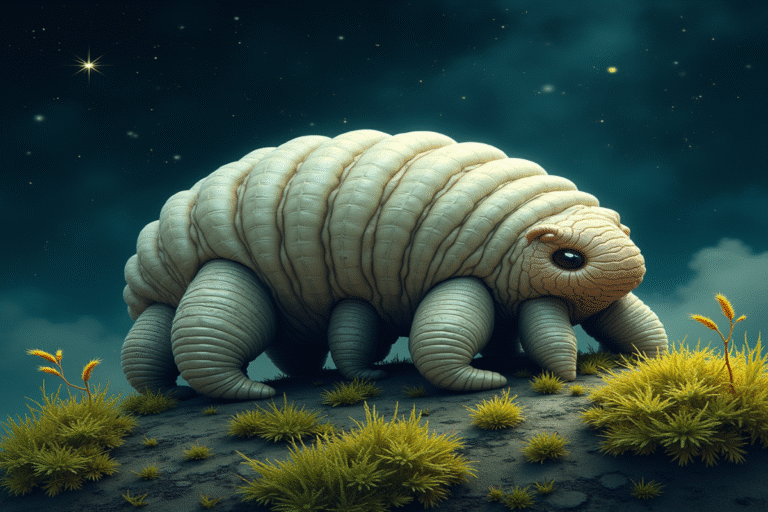Imagine a creature so resilient it can survive being boiled, frozen, crushed under extreme pressure, deprived of oxygen, and even withstand the vacuum of space. This isn’t science fiction—it’s the remarkable reality of tardigrades, often called water bears or moss piglets.
Meet the Virtually Indestructible Micro-Animal
Tardigrades are microscopic, eight-legged animals, typically about 0.5 mm long when fully grown, that have conquered virtually every habitat on Earth—from the deepest ocean trenches to the highest mountains. What makes them extraordinary is not just their ubiquity, but their unparalleled survival skills.
These tiny creatures can withstand conditions that would instantly kill almost any other living organism. They can survive temperatures close to absolute zero (-458°F / -272°C) to around 304°F (151°C), pressures more than six times greater than those found in the deepest ocean trenches, radiation levels thousands of times higher than what would be lethal to humans, and can go without water for decades.
The Cryptobiosis Superpower
The secret to tardigrades’ survival lies primarily in their ability to enter a state called cryptobiosis—essentially a state where all measurable metabolic processes stop. When facing harsh conditions, tardigrades can reduce their water content to less than 3% of normal, shrinking into a dehydrated, barrel-like structure called a tun.
In this tun state, tardigrades replace water in their cells with a sugar called trehalose, which forms a gel-like substance that prevents cellular damage. Their metabolism slows to 0.01% of normal, and they can remain in this suspended animation for decades—only to revive within hours when exposed to water again.
Damage-Resistant DNA
One of the most remarkable aspects of tardigrade biology is their ability to resist radiation damage. Research published in Nature Communications revealed a unique protein called Dsup (Damage Suppressor) that physically shields their DNA from radiation’s harmful effects.
When scientists transferred this protein to human cells in laboratory experiments, the human cells showed a 40% reduction in X-ray damage compared to untreated cells. This discovery has profound implications for radiation protection technologies and even space travel.
Cellular Adaptations for Extreme Conditions
Tardigrades possess several molecular adaptations that protect their cellular structures:
- Heat shock proteins that help prevent other proteins from unfolding or misfolding under stress
- Intrinsically disordered proteins that form glass-like structures around cellular components, protecting them when dehydrated
- Efficient DNA repair mechanisms that quickly fix damage when they rehydrate
- Antioxidant enzymes that neutralize harmful reactive oxygen species generated during stress
Surviving the Vacuum of Space
Perhaps most astonishingly, tardigrades are among the very few animals known to have survived direct exposure to the vacuum of space. In 2007, researchers sent dehydrated tardigrades on the FOTON-M3 mission outside Earth’s atmosphere. After returning to Earth and being rehydrated, many of them successfully recovered and even reproduced normally.
This space survival is particularly remarkable because it means tardigrades withstood not only the vacuum but also unfiltered solar and cosmic radiation that would destroy most DNA.
Evolutionary Puzzle
What makes tardigrades even more fascinating is that their extreme resilience doesn’t seem to align with their natural habitats. Most species live in relatively mild environments where such survival mechanisms aren’t regularly needed. Scientists believe these adaptations may have evolved to survive periodic drying of their microhabitats, with the extreme survival abilities being a fortunate byproduct.
Genomic studies have revealed another surprise—tardigrades have acquired thousands of foreign genes through horizontal gene transfer, primarily from bacteria, fungi, and plants. This genetic borrowing may contribute to their extraordinary adaptability.
Applications in Science and Technology
Researchers are studying tardigrade biology for numerous applications:
- Developing better methods for preserving vaccines without refrigeration
- Creating more effective radiation shields for astronauts
- Engineering drought-resistant crops
- Advancing medical preservation techniques for organs and tissues
These microscopic survivors hold valuable secrets that could revolutionize multiple fields of science and technology. Their ability to withstand conditions that would destroy most life forms makes them not only biological marvels but potentially crucial tools for solving some of humanity’s greatest challenges.
The next time you step on moss or lichen, remember you’re walking on the habitat of perhaps the toughest animals on Earth—resilient little creatures that could likely survive apocalyptic conditions that would wipe out most other life on our planet.





